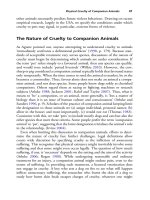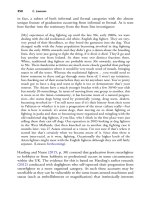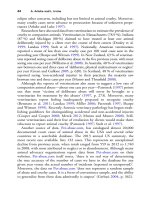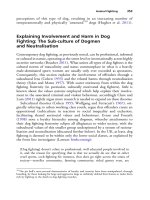The palgrave international handbook of a 52
Bạn đang xem bản rút gọn của tài liệu. Xem và tải ngay bản đầy đủ của tài liệu tại đây (27.96 KB, 1 trang )
40
A. Arluke and L. Irvine
Not everyone responds sympathetically to animal cruelty, however. Some
people consider the victims ‘just’ animals and the investigations a diversion of
law enforcement’s limited resources. Moreover, judging from common references to cruelty in popular culture, many people accept or selectively ignore
it. They talk about ‘killing two birds with one stone’ and ‘being a guinea pig’,
unaware of the suffering implied by the language of these sayings. In addition, people often find depictions of animal suffering humorous. Over a
million websites offer jokes about animal abuse or cruelty. In the film
There’s Something about Mary, Matt Dillon’s character gives Puffy—a
dog—sedatives. He gives him too much, however, and Puffy passes out. In
trying to revive the dog, Dillon’s character takes the wires from a lamp and
administers an electric shock that causes Puffy to catch fire. Many—if not
all—of director Wes Anderson’s films involve the killing of companion animals. In The Royal Tenenbaums, grandfather Royal runs over a dog while
taking his grandchildren on an excursion. In The Grand Budapest Hotel, a
character throws a cat out a window. The camera pans over the window ledge
and down to the street to show the cat, dead on the cobblestones below. As
Arluke (2002, p. 427) writes, ‘humorous slants on cruelty are plentiful and can
be seen in children’s stories, cartoons, and comics, as well as in adult advertising, movies, and even occasional talk-radio programs, that have long been
known to make light of animals being harmed or even killed.’
These examples point out the ambiguity surrounding the meaning and
significance of animal cruelty and the ambivalence that characterises our treatment of animals (Arluke 2006; Arluke and Sanders 1996). The contradictions in
how we regard animals seem greatest when we look at our varied relationships
with companion animals, ranging from complete devotion to indifference.
Animal cruelty can constitute a crime against innocence and a sign of psychopathology. It can prompt collective sympathy and anger—or indifference. It can
function as a marketing strategy, a metaphor, a joke or a cinematic device.
Treatment considered abhorrent in one situation can become acceptable in
another. An act intended to make a point in a movie or a cartoon takes on an
entirely different meaning if inflicted on a living dog or cat.
In this chapter, we reveal how the ambiguous, conflicting nature of cruelty
has shaped attempts to explain it, document its prevalence and determine
appropriate ways of responding to it. Focusing on animals typically considered companions allows us to sift through some of the distortions and
projections that surround dominant interpretations of cruelty. Using a
symbolic interactionist perspective, we question the belief that cruelty has
an objective definition, independent of context (Blumer 1986; Mead 1934).
We also challenge the assumption that harming companion animals as well as









